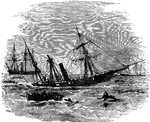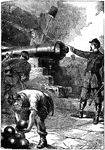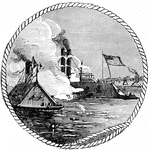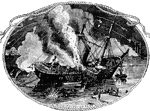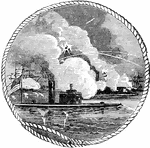The 1861-1865 Civil War Naval Battles ClipArt gallery includes 90 illustrations of naval battles that were fought between the Union and Confederacy during the American Civil War.

Acquia Creek
"The attack upon the batteries at the entrance of Acquia Creek, Potomac River, by the United States…
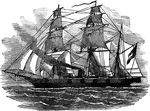
The Alabama
The Alabama was a Confederate man-of-war built by the British. It served as a commerce raider attacking…

Destruction of the Albemarle
William Barker Cushing was an officer in the United States Navy, best known for sinking the Confederate…

Anne
"Capture of the British steamer Anne laden with arms and munition of war for the Confederates,…

Destruction of the Arkansas
Destruction of the Arkansas during the Battle of Baton Rouge naval battle.

Banks Expedition
"The Banks Expedition- scene on the hurricane deck of the United States transport North Star-…
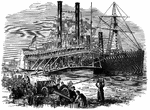
Banks Expedition
"The Banks Expedition- scene on the levee, Baton Rouge, La. Contrabands unloading military stores from…

Banks's Expedition
"Banks's Expedition- Executive Officer Parker, of the United States gunboat Essex, hoisting…
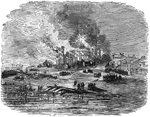
Burning of Baton Rouge
"Banks's Expedition- burning of the state capitol of Louisiana, Baton Rouge, Tuesday night, December…
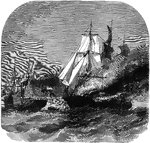
Harvey Birch
"Burning of the American merchantman "Harvey Birch," of New York, Captain Nelson, in the British Channel,…

Che-Kiang
"The Banks Expedition- a Confederate Schooner running into the United States transport Che-Kiang,…
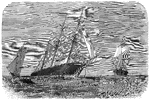
Victory off Cherbourg
"The naval victory off Cherbourg, France, June 19th, 1864- the pirate Alabama Captain Semmes,…

Commodore Barney
"The war in Virginia. Explosion of a torpedo under the Commodore Barney, on James River, August…

Burning of Confederate gunboats
"Burning of the Confederate gunboats, rams, etc., at New Orleans and Algiers, on the approach of the…

First naval battle
"First naval battle in Hampton Roads between the Confederate iron-plated steamers Merrimac, Yorktown,…

Bombardment of Fort Henry
"Bombardment of Fort Henry, Tennessee River, Tenn., by the Mississippi Flotilla, Flag Officer Foote,…
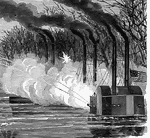
Bombardment of Fort Henry
"Bombardment of Fort Henry, Tennessee River, Tenn., by the Mississippi Flotilla, Flag Officer Foote,…

Bombardment of Fort Henry
"Bombardment of Fort Henry, Tennessee River, Tenn., by the Mississippi Flotilla, Flag Officer Foote,…
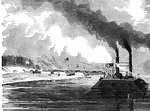
Bombardment of Fort Henry
"Bombardment of Fort Henry, Tennessee River, Tenn., by the Mississippi Flotilla, Flag Officer Foote,…

Fort Hindman
"The investment of Fort Hindman, Arkansas Post, Ark., by the Federal troops under General McClernand,…

Passage of Forts Jackson and St. Phillip
Depiction of the battle on the Mississippi between Confederate and Union forces at Forts Jackson and…

Galveston
"Shelling of the batteries at Galveston by the United States war steamer South Carolina, on…

Gunboat collision
"Desperate engagement, april 24th, 1862, between the United States gunboat "Varuna," Commander Boggs,…
Gunboat engagement
"Engagement between the United States gunboats, commanded by Commodore Davis, and the Confederate Mosquito…

Gunboat of the Mississippi
A gunboat of the Mississippi. Gunboats Essex, Carondelete, Cincinnati, St. Louis, and Benton steamed…

Gunboats
Gunboats in the James River off the Virginia coast. Gunboats were boats used for carrying one or more…

Gunboats Ascending the Yazoo River
The Yazoo River was of major importance during the American Civil War. The first electrically detonated…
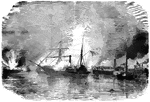
Harriet Lane
"Daring and desperate attack- surprise and capture of the United States gunboat Harriet Lane…

Iroquois
"Terrible effect of a discharge of grape from Fort Jackson on the Federal gunboat Iroquois,…

Bombardment of Island No. 10
"Bombardment of Island No. 10 and the fortifications opposite, on the Kentucky Shore, by the Federal…

Fort Jackson
"Bombardment of Forts Jackson and St. Philip- the United States squadron, under Farragut, engaging the…

Kearsarge Sinking the Alabama
The sinking of the Alabama by the Union Kearsarge. Some Confederates aboard the Alabama escaped to England…

Fort McAllister
"Bombardment of Fort McAllister, Ogeechee River, Ga., by the union ironclads Patapsco, Passaic…

Destruction of Merrimac
"Destruction of the Confederate ironclad steamer Merrimac, blown up by its commander, on the…

Opening of the Battle of Mobile Bay
The Battle of Mobile Bay was a naval battle fought on August 5, 1864, during the American Civil War.

Capture of Fort Morgan, Mobile Bay
The Siege of Fort Morgan occurred during the American Civil War as part of the battle for Mobile Bay…
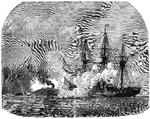
Mobile Harbor
"Farragut's naval victory in Mobile Harbor. The Hartford engaging the Confederate ram Tennessee.…
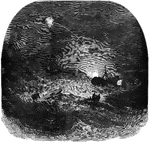
Monitor
"Loss of the Monitor- gallant attempt of the officers and crew of the United States steamer…
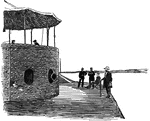
Monitor
Navy soldiers on the deck of the Monitor, a warship famous for the battle with the Merrimac.
Fort Moultrie
"Siege of Charleston, S. C. Bombardment of Fort Moultrie and Batteries Bee and Beauregard by the monitors…

Destruction of Nashville
"Destruction of the famous Confederate privateer Nashville, in the Ogeechee River, Ga., by…

Naval Battle
"Naval action between the United States war steamer Mississippi and the Confederate iron-cased…

The Great Naval Battle of the Mississippi
Passage of the second division of the Federal Squadron past Fort St. Philip. On April 24, 1862 at three…

The Great Naval Battle on the Mississippi
First day's bombardment, Federal Schooners off Forts Jackson and St. Philip, commanding the passage…





